HP 39gs User Manual

HP 39gs graphing calculator
user's guide
Edition3
Part Number F2223AA-90001

Notice
REGISTER YOUR PRODUCT AT: www.register.hp.com
THIS MANUAL AND ANY EXAMPLES CONTAINED HEREIN ARE PROVIDED “AS IS” AND ARE SUBJECT TO CHANGE WITHOUT NOTICE. HEWLETT-PACKARD COMPANY MAKES NO WARRANTY OF ANY KIND WITH REGARD TO THIS MANUAL, INCLUDING, BUT NOT LIMITED TO, THE IMPLIED WARRANTIES OF MERCHANTABILITY, NON-INFRINGEMENT AND FITNESS FOR A PARTICULAR PURPOSE.
HEWLETT-PACKARD CO. SHALL NOT BE LIABLE FOR ANY ERRORS OR FOR INCIDENTAL OR CONSEQUENTIAL DAMAGES IN CONNECTION WITH THE FURNISHING, PERFORMANCE, OR USE OF THIS MANUAL OR THE EXAMPLES CONTAINED HEREIN.
© 1994-1995, 1999-2000, 2003, 2006 Hewlett-Packard Development Company, L.P.
Reproduction, adaptation, or translation of this manual is prohibited without prior written permission of Hewlett-Packard Company, except as allowed under the copyright laws.
Hewlett-Packard Company
16399 West Bernardo Drive
MS 8-600
San Diego, CA 92127-1899
USA
Printing History
Edition 2 |
December 2003 |
Edition 3 |
June 2005 |

Contents
Preface
Manual conventions .............................................................. |
P-1 |
Notice ................................................................................. |
P-2 |
1 Getting started |
|
On/off, cancel operations...................................................... |
1-1 |
The display .......................................................................... |
1-2 |
The keyboard ....................................................................... |
1-3 |
Menus ................................................................................. |
1-8 |
Input forms ........................................................................... |
1-9 |
Mode settings ..................................................................... |
1-10 |
Setting a mode............................................................... |
1-11 |
Aplets (E-lessons)................................................................. |
1-12 |
Aplet library .................................................................. |
1-16 |
Aplet views.................................................................... |
1-16 |
Aplet view configuration.................................................. |
1-18 |
Mathematical calculations .................................................... |
1-19 |
Using fractions.................................................................... |
1-25 |
Complex numbers ............................................................... |
1-29 |
Catalogs and editors ........................................................... |
1-30 |
2 Aplets and their views |
|
Aplet views .......................................................................... |
2-1 |
About the Symbolic view ................................................... |
2-1 |
Defining an expression (Symbolic view) .............................. |
2-1 |
Evaluating expressions ...................................................... |
2-3 |
About the Plot view........................................................... |
2-5 |
Setting up the plot (Plot view setup)..................................... |
2-5 |
Exploring the graph .......................................................... |
2-7 |
Other views for scaling and splitting the graph .................. |
2-13 |
About the numeric view................................................... |
2-16 |
Setting up the table (Numeric view setup) .......................... |
2-16 |
Exploring the table of numbers ......................................... |
2-17 |
Building your own table of numbers.................................. |
2-19 |
“Build Your Own” menu keys........................................... |
2-20 |
Example: plotting a circle ................................................ |
2-20 |
i

3 |
Function aplet |
|
|
About the Function aplet........................................................ |
3-1 |
|
Getting started with the Function aplet ................................ |
3-1 |
|
Function aplet interactive analysis........................................... |
3-9 |
|
Plotting a piecewise-defined function ................................ |
3-12 |
4 |
Parametric aplet |
|
|
About the Parametric aplet .................................................... |
4-1 |
|
Getting started with the Parametric aplet............................. |
4-1 |
5 |
Polar aplet |
|
|
Getting started with the Polar aplet ......................................... |
5-1 |
6 |
Sequence aplet |
|
|
About the Sequence aplet...................................................... |
6-1 |
|
Getting started with the Sequence aplet .............................. |
6-1 |
7 |
Solve aplet |
|
|
About the Solve aplet............................................................ |
7-1 |
|
Getting started with the Solve aplet .................................... |
7-2 |
|
Use an initial guess............................................................... |
7-5 |
|
Interpreting results ................................................................ |
7-6 |
|
Plotting to find guesses .......................................................... |
7-7 |
|
Using variables in equations ................................................ |
7-10 |
8 |
Linear Solver aplet |
|
|
About the Linear Solver aplet ................................................. |
8-1 |
|
Getting started with the Linear Solver aplet.......................... |
8-1 |
9 |
Triangle Solve aplet |
|
|
About the Triangle Solver aplet .............................................. |
9-1 |
|
Getting started with the Triangle Solver aplet....................... |
9-1 |
10 Statistics aplet |
|
|
|
About the Statistics aplet...................................................... |
10-1 |
|
Getting started with the Statistics aplet.............................. |
10-1 |
|
Entering and editing statistical data ...................................... |
10-6 |
|
Defining a regression model.......................................... |
10-12 |
|
Computed statistics ........................................................... |
10-14 |
|
Plotting............................................................................ |
10-15 |
|
Plot types .................................................................... |
10-16 |
|
Fitting a curve to 2VAR data ......................................... |
10-17 |
|
Setting up the plot (Plot setup view) ................................ |
10-18 |
|
Trouble-shooting a plot ................................................. |
10-19 |
ii

Exploring the graph ...................................................... |
10-19 |
Calculating predicted values.......................................... |
10-20 |
11 Inference aplet |
|
About the Inference aplet ..................................................... |
11-1 |
Getting started with the Inference aplet ............................. |
11-1 |
Importing sample statistics from the Statistics aplet .............. |
11-4 |
Hypothesis tests .................................................................. |
11-8 |
One-Sample Z-Test.......................................................... |
11-8 |
Two-Sample Z-Test .......................................................... |
11-9 |
One-Proportion Z-Test.................................................... |
11-10 |
Two-Proportion Z-Test .................................................... |
11-11 |
One-Sample T-Test ........................................................ |
11-12 |
Two-Sample T-Test ........................................................ |
11-14 |
Confidence intervals.......................................................... |
11-15 |
One-Sample Z-Interval................................................... |
11-15 |
Two-Sample Z-Interval ................................................... |
11-16 |
One-Proportion Z-Interval............................................... |
11-17 |
Two-Proportion Z-Interval ............................................... |
11-17 |
One-Sample T-Interval ................................................... |
11-18 |
Two-Sample T-Interval.................................................... |
11-19 |
12 Using the Finance Solver |
|
Background........................................................................ |
12-1 |
Performing TVM calculations ................................................ |
12-4 |
Calculating Amortizations................................................ |
12-7 |
13 Using mathematical functions |
|
Math functions .................................................................... |
13-1 |
The MATH menu ............................................................ |
13-1 |
Math functions by category .................................................. |
13-2 |
Keyboard functions......................................................... |
13-3 |
Calculus functions........................................................... |
13-6 |
Complex number functions............................................... |
13-7 |
Constants ...................................................................... |
13-8 |
Conversions................................................................... |
13-8 |
Hyperbolic trigonometry.................................................. |
13-9 |
List functions ................................................................ |
13-10 |
Loop functions.............................................................. |
13-10 |
Matrix functions ........................................................... |
13-11 |
Polynomial functions ..................................................... |
13-11 |
Probability functions...................................................... |
13-12 |
Real-number functions ................................................... |
13-13 |
iii

Two-variable statistics ................................................... |
13-17 |
Symbolic functions ....................................................... |
13-17 |
Test functions............................................................... |
13-18 |
Trigonometry functions.................................................. |
13-19 |
Symbolic calculations........................................................ |
13-20 |
Finding derivatives....................................................... |
13-21 |
Program constants and physical constants ........................... |
13-24 |
Program constants........................................................ |
13-24 |
Physical constants ........................................................ |
13-25 |
14 Variables and memory management |
|
Introduction ....................................................................... |
14-1 |
Storing and recalling variables............................................. |
14-2 |
The VARS menu.................................................................. |
14-4 |
Memory Manager .............................................................. |
14-9 |
15 Matrices |
|
Introduction ....................................................................... |
15-1 |
Creating and storing matrices .............................................. |
15-2 |
Working with matrices ........................................................ |
15-4 |
Matrix arithmetic ................................................................ |
15-6 |
Solving systems of linear equations .................................. |
15-8 |
Matrix functions and commands ......................................... |
15-10 |
Argument conventions .................................................. |
15-10 |
Matrix functions ........................................................... |
15-10 |
Examples......................................................................... |
15-13 |
16 Lists |
|
Displaying and editing lists .................................................. |
16-4 |
Deleting lists.................................................................. |
16-6 |
Transmitting lists............................................................. |
16-6 |
List functions....................................................................... |
16-6 |
Finding statistical values for list elements................................ |
16-9 |
17 Notes and sketches |
|
Introduction ....................................................................... |
17-1 |
Aplet note view .................................................................. |
17-1 |
Aplet sketch view................................................................ |
17-3 |
The notepad ...................................................................... |
17-6 |
18 Programming |
|
Introduction ....................................................................... |
18-1 |
Program catalog ............................................................ |
18-2 |
Creating and editing programs ............................................ |
18-4 |
iv

Using programs .................................................................. |
18-7 |
Customizing an aplet........................................................... |
18-9 |
Aplet naming convention............................................... |
18-10 |
Example...................................................................... |
18-10 |
Programming commands.................................................... |
18-13 |
Aplet commands .......................................................... |
18-14 |
Branch commands ........................................................ |
18-17 |
Drawing commands...................................................... |
18-19 |
Graphic commands ...................................................... |
18-21 |
Loop commands ........................................................... |
18-23 |
Matrix commands......................................................... |
18-24 |
Print commands............................................................ |
18-26 |
Prompt commands ........................................................ |
18-26 |
Stat-One and Stat-Two commands .................................. |
18-30 |
Stat-Two commands ...................................................... |
18-30 |
Storing and retrieving variables in programs.................... |
18-31 |
Plot-view variables ........................................................ |
18-32 |
Symbolic-view variables ................................................ |
18-39 |
Numeric-view variables ................................................. |
18-41 |
Note variables ............................................................. |
18-44 |
Sketch variables ........................................................... |
18-44 |
19 Extending aplets |
|
Creating new aplets based on existing aplets ......................... |
19-1 |
Using a customized aplet ................................................ |
19-3 |
Resetting an aplet................................................................ |
19-3 |
Annotating an aplet with notes ............................................. |
19-4 |
Annotating an aplet with sketches ......................................... |
19-4 |
Downloading e-lessons from the web..................................... |
19-4 |
Sending and receiving aplets ............................................... |
19-4 |
Sorting items in the aplet library menu list .............................. |
19-6 |
Reference information |
|
Glossary .............................................................................. |
R-1 |
Resetting the HP 39gs............................................................ |
R-3 |
To erase all memory and reset defaults................................ |
R-3 |
If the calculator does not turn on......................................... |
R-4 |
Operating details.................................................................. |
R-4 |
Batteries .......................................................................... |
R-4 |
Variables ............................................................................. |
R-6 |
Home variables................................................................ |
R-6 |
Function aplet variables..................................................... |
R-7 |
Parametric aplet variables ................................................. |
R-8 |
v

Polar aplet variables ........................................................ |
R-9 |
Sequence aplet variables ................................................ |
R-10 |
Solve aplet variables ...................................................... |
R-11 |
Statistics aplet variables.................................................. |
R-12 |
MATH menu categories....................................................... |
R-13 |
Math functions............................................................... |
R-13 |
Program constants.......................................................... |
R-15 |
Physical Constants ......................................................... |
R-16 |
Program commands ....................................................... |
R-17 |
Status messages ................................................................. |
R-18 |
Limited Warranty |
|
Service .......................................................................... |
W-3 |
Regulatory information..................................................... |
W-5 |
Index
vi

Preface
The HP 39gs is a feature-rich graphing calculator. It is also a powerful mathematics learning tool. The HP 39gs is designed so that you can use it to explore mathematical functions and their properties.
You can get more information on the HP 39gs from Hewlett-Packard’s Calculators web site. You can download customized aplets from the web site and load them onto your calculator. Customized aplets are special applications developed to perform certain functions, and to demonstrate mathematical concepts.
Hewlett Packard’s Calculators web site can be found at:
http://www.hp.com/calculators
Manual conventions
The following conventions are used in this manual to represent the keys that you press and the menu options that you choose to perform the described operations.
•Key presses are represented as follows:
 ,
,  ,
,  , etc.
, etc.
•Shift keys, that is the key functions that you access by
pressing the  key first, are represented as follows:
key first, are represented as follows:
 CLEAR,
CLEAR,  MODES,
MODES,  ACOS, etc.
ACOS, etc.
•Numbers and letters are represented normally, as follows:
5, 7, A, B, etc.
•Menu options, that is, the functions that you select using the menu keys at the top of the keypad are represented as follows:
 ,
,  ,
,  .
.
•Input form fields and choose list items are represented as follows:
Function, Polar, Parametric
•Your entries as they appear on the command line or within input forms are represented as follows:
2*X2-3X+5
P-1

Notice
This manual and any examples contained herein are provided as-is and are subject to change without notice. Except to the extent prohibited by law, Hewlett-Packard Company makes no express or implied warranty of any kind with regard to this manual and specifically disclaims the implied warranties and conditions of merchantability and fitness for a particular purpose and Hewlett-Packard Company shall not be liable for any errors or for incidental or consequential damage in connection with the furnishing, performance or use of this manual and the examples herein.
♥ 1994–1995, 1999–2000, 2003–2006 Hewlett-
Packard Development Company, L.P.
The programs that control your HP 39gs are copyrighted and all rights are reserved. Reproduction, adaptation, or translation of those programs without prior written permission from Hewlett-Packard Company is also prohibited.
P-2

1
Getting started
On/off, cancel operations
To turn on |
Press |
to turn on the calculator. |
|
|
To cancel |
When the calculator is on, the |
key cancels the |
||
|
current operation. |
|
|
|
To turn off |
Press |
OFF to turn the calculator off. |
||
|
To save power, the calculator turns itself off after several |
|||
|
minutes of inactivity. All stored and displayed information |
|||
|
is saved. |
|
|
|
|
If you see the ((•)) annunciator or the Low Bat message, |
|||
|
then the calculator needs fresh batteries. |
|||
HOME |
HOME is the calculator’s home view and is common to all |
|||
|
aplets. If you want to perform calculations, or you want to |
|||
|
quit the current activity (such as an aplet, a program, or |
|||
|
an editor), press |
. All mathematical functions are |
||
|
available in the HOME. The name of the current aplet is |
|||
|
displayed in the title of the home view. |
|||
Protective cover |
The calculator is provided with a slide cover to protect the |
|||
|
display and keyboard. Remove the cover by grasping |
|||
|
both sides of it and pulling down. |
|
||
You can reverse the slide cover and slide it onto the back of the calculator. this will help prevent you losing the cover while you are using the calculator.
To prolong the life of the calculator, always place the cover over the display and keyboard when you are not using the calculator.
Getting started |
1-1 |

The display
To adjust the |
Simultaneously press |
and |
(or |
) to increase (or |
contrast |
decrease) the contrast. |
|
|
|
To clear the display |
• Press CANCEL to clear the edit line. |
|
||
•Press  CLEAR to clear the edit line and the display history.
CLEAR to clear the edit line and the display history.
Parts of the display
History |
|
|
|
|
Title |
|
|
|
|
|
|||
|
|
|
|
|
|
|
|
|
|
|
|
||
|
|
|
|
|
|
|
Edit line |
|
|
|
|
Menu key |
|
|
|
|
|
|||
|
|
|
|
|
|
|
|
|
|
|
|
|
labels |
|
|
|
|
|||
Menu key or soft key labels. The labels for the menu keys’ current meanings.  is the label for the first menu key in this picture. “Press
is the label for the first menu key in this picture. “Press  ” means to press the first menu key, that is, the leftmost top-row key on the calculator keyboard.
” means to press the first menu key, that is, the leftmost top-row key on the calculator keyboard.
Edit line. The line of current entry.
History. The HOME display ( ) shows up to four lines of history: the most recent input and output. Older lines scroll off the top of the display but are retained in memory.
) shows up to four lines of history: the most recent input and output. Older lines scroll off the top of the display but are retained in memory.
Title. The name of the current aplet is displayed at the top of the HOME view. RAD, GRD, DEG specify whether Radians, Grads or Degrees angle mode is set for HOME. The and symbols indicate whether there is more history in the HOME display. Press the  and
and  to scroll in the HOME display.
to scroll in the HOME display.
N O T E This user’s guide contains images from the HP 39gs and does not display the  menu key label.
menu key label.
1-2 |
Getting started |
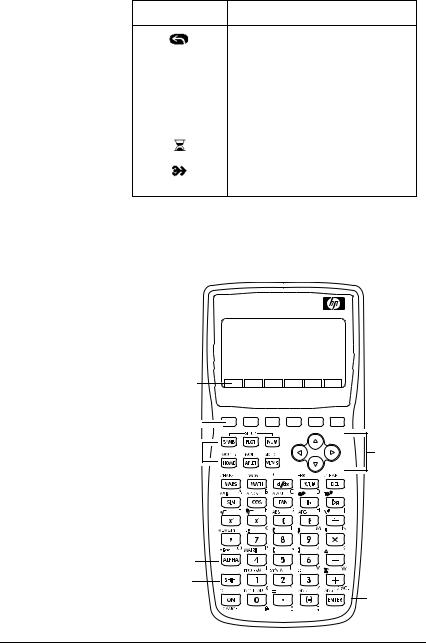
Annunciators. Annunciators are symbols that appear above the title bar and give you important status information.
Annunciator Description
Shift in effect for next keystroke.
To cancel, press  again.
again.
αAlpha in effect for next keystroke. To cancel, press  again.
again.
((•)) |
Low battery power. |
|
Busy. |
|
Data is being transferred via |
|
infrared or cable. |
The keyboard
Menu keys
HP 39gs
Graphing Calculator
Menu Key
Labels
Menu Keys
Aplet Control 
Keys
Alpha Key
Shift Key
Cursor
Keys
Enter
Key
Getting started |
1-3 |

•On the calculator keyboard, the top row of keys are called menu keys. Their meanings depend on the context—that’s why their tops are blank. The menu keys are sometimes called “soft keys”.
•The bottom line of the display shows the labels for the menu keys’ current meanings.
Aplet control keys
The aplet control keys are:
Key |
Meaning |
|
|
|
Displays the Symbolic view for the |
|
current aplet. See “Symbolic view” |
|
on page 1-16. |
|
Displays the Plot view for the current |
|
aplet. See “Plot view” on page 1-16. |
|
Displays the Numeric view for the |
|
current aplet. See “Numeric view” on |
|
page 1-17. |
|
Displays the HOME view. See |
|
“HOME” on page 1-1. |
|
Displays the Aplet Library menu. See |
|
“Aplet library” on page 1-16. |
|
Displays the VIEWS menu. See |
|
“Aplet views” on page 1-16. |
|
|
1-4 |
Getting started |

Entry/Edit keys
The entry and edit keys are:
Key |
|
|
Meaning |
|
|
|
|
|
|
|
|||
|
(CANCEL) |
|
Cancels the current operation if the |
|||
|
|
|
calculator is on by pressing |
. |
||
|
|
|
Pressing |
, then OFF turns the |
||
|
|
|
calculator off. |
|
|
|
|
|
|
Accesses the function printed in blue |
|||
|
|
|
above a key. |
|
|
|
|
|
|
Returns to the HOME view, for |
|
||
|
|
|
performing calculations. |
|
||
|
|
|
Accesses the alphabetical |
|
||
|
|
|
characters printed in orange below |
|||
|
|
|
a key. Hold down to enter a string |
|||
|
|
|
of characters. |
|
|
|
|
|
|
Enters an input or executes an |
|
||
|
|
|
operation. In calculations, |
|
||
|
|
|
acts like “=”. When |
or |
|
|
|
|
|
is present as a menu key, |
|
||
|
|
|
acts the same as pressing |
or |
||
|
|
|
. |
|
|
|
|
|
|
Enters a negative number. To enter |
|||
|
|
|
–25, press |
25. Note: this is not |
||
|
|
|
the same operation that the subtract |
|||
|
|
|
button performs ( |
). |
|
|
|
|
|
Enters the independent variable by |
|||
|
|
|
inserting X, T, θ, or N into the edit |
|||
|
|
|
line, depending on the current |
|
||
|
|
|
active aplet. |
|
|
|
|
|
|
Deletes the character under the |
|||
|
|
|
cursor. Acts as a backspace key if |
|||
|
|
|
the cursor is at the end of the line. |
|||
|
CLEAR |
|
Clears all data on the screen. On a |
|||
|
|
|
settings screen, for example Plot |
|||
|
|
|
Setup, |
CLEAR returns all |
|
|
|
|
|
settings to their default values. |
|
||
, |
, |
, |
Moves the cursor around the |
|
||
|
|
|
display. Press |
|
first to move to |
|
|
|
|
the beginning, end, top or bottom. |
|||
|
|
|
|
|
|
|
Getting started |
1-5 |

Key |
Meaning |
(Continued) |
|
|
|
||
CHARS |
Displays a menu of all available |
||
|
characters. To type one, use the |
||
|
arrow keys to highlight it, and press |
||
|
. To select multiple characters, |
||
|
select each and press |
, then |
|
|
press |
. |
|
|
|
|
|
Shifted keystrokes
There are two shift keys that you use to access the operations and characters printed above the keys:  and
and  .
.
Key Description
Press the  key to access the operations printed in blue above the keys. For instance, to access the Modes screen, press
key to access the operations printed in blue above the keys. For instance, to access the Modes screen, press  , then press
, then press  . (MODES is labeled in blue above the
. (MODES is labeled in blue above the  key). You do not need to hold down
key). You do not need to hold down  when you press HOME. This action is depicted in this manual as “press
when you press HOME. This action is depicted in this manual as “press
MODES.”
To cancel a shift, press  again.
again.
The alphabetic keys are also shifted keystrokes. For instance, to type Z, press  Z. (The letters are printed in orange to the lower right of each key.)
Z. (The letters are printed in orange to the lower right of each key.)
To cancel Alpha, press  again.
again.
For a lower case letter, press 
 .
.
For a string of letters, hold down  while typing.
while typing.
1-6 |
Getting started |

HELPWITH |
The HP 39gs built-in help is available in HOME only. It |
||
|
provides syntax help for built-in math functions. |
||
|
Access the HELPWITH command by pressing |
||
|
SYNTAX and then the math key for which you require |
||
|
syntax help. |
|
|
Example |
Press |
SYNTAX |
|
|
|||
|
|
|
|
Note: Remove the left parenthesis from built-in functions such as sine, cosine, and tangent before invoking the HELPWITH command.
Math keys |
HOME ( |
) is the place to do calculations. |
Keyboard keys. The most common operations are available from the keyboard, such as the arithmetic (like  ) and trigonometric (like
) and trigonometric (like  ) functions. Press
) functions. Press  to complete the operation:
to complete the operation:
 256
256  displays 16.
displays 16.
.
MATH menu. Press
 to open the MATH menu. The MATH menu is a comprehensive list of math functions that do not appear on the keyboard. It also
to open the MATH menu. The MATH menu is a comprehensive list of math functions that do not appear on the keyboard. It also
includes categories for all other functions and constants. The functions are grouped by category, ranging in alphabetical order from Calculus to Trigonometry.
•The arrow keys scroll through the list ( ,
,  ) and move from the category list in the left column to the item list in the right column (
) and move from the category list in the left column to the item list in the right column ( ,
,  ).
).
•Press  to insert the selected command onto the edit line.
to insert the selected command onto the edit line.
•Press  to dismiss the MATH menu without selecting a command.
to dismiss the MATH menu without selecting a command.
•Pressing  displays the list of Program Constants. You can use these in programs that you develop.
displays the list of Program Constants. You can use these in programs that you develop.
Getting started |
1-7 |
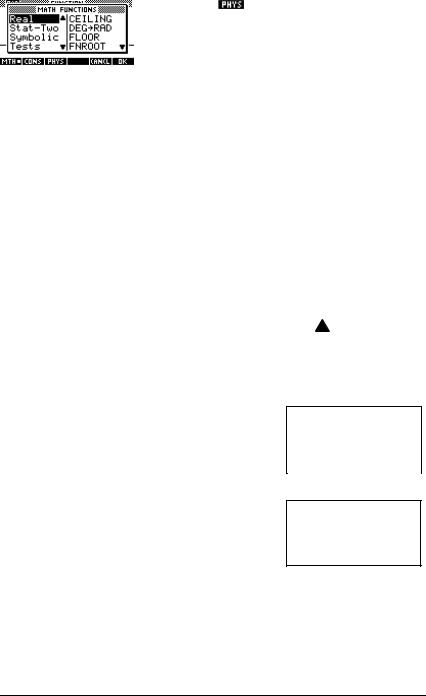
• |
Pressing |
displays a menu of physical |
|
constants from the fields of chemistry, physics, |
|
|
and quantum mechanics. You can use these |
|
|
constants in calculations. (See “Physical |
|
|
constants” on page 13-25 for more information.) |
|
• |
Pressing |
takes you to the beginning of the |
|
MATH menu. |
|
|
|
See “Math functions by category” on page 13-2 for |
|
|
|
details of the math functions. |
|
|
H I N T |
|
|
|
When using the MATH menu, or any menu on the |
|
||
|
hp 39gs, pressing an alpha key takes you straight to the |
||
|
first menu option beginning with that alpha character. |
||
|
With this method, you do not need to press |
first. |
|
|
Just press the key that corresponds to the command’s |
||
|
beginning alpha character. |
|
|
Program |
|
|
|
Pressing |
CMDS displays the list of Program |
|
|
commands |
Commands. See “Programming commands” on |
|
|
|
page 18-13. |
|
|
Inactive keys |
If you press a key that does not operate in the current |
||
|
context, a warning symbol like this ! appears. There is |
||
|
no beep. |
|
|
Menus
A menu offers you a choice of items. Menus are displayed in one or two columns.
•The  arrow in the display means more items below.
arrow in the display means more items below.
•The  arrow in the
arrow in the
display means more items above.
To search a menu |
• Press |
or |
to scroll through the list. If you press |

 or
or 
 , you’ll go all the way to the end or the beginning of the list. Highlight the item
, you’ll go all the way to the end or the beginning of the list. Highlight the item
you want to select, then press  (or
(or  ).
).
1-8 |
Getting started |
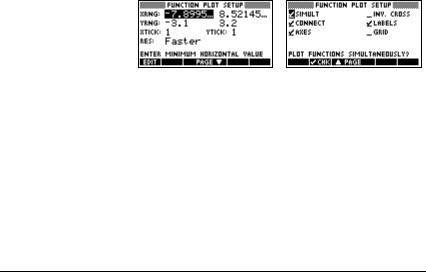
To cancel a menu
Input forms
Reset input form values
•If there are two columns, the left column shows general categories and the right column shows specific contents within a category. Highlight a general category in the left column, then highlight an item in the right column. The list in the right column changes when a different category is highlighted.
Press  or
or  when you have highlighted your selection.
when you have highlighted your selection.
•To speed-search a list, type the first letter of the word.
For example, to find the Matrix category in  , press
, press  , the Alpha “M” key.
, the Alpha “M” key.
•To go up a page, you can press 
 . To go down a page, press
. To go down a page, press 
 .
.
Press  (for CANCEL) or
(for CANCEL) or  . This cancels the current operation.
. This cancels the current operation.
An input form shows several fields of information for you to examine and specify. After highlighting the field to edit, you can enter or edit a number (or expression). You can also select options from a list ( ). Some input forms include items to check (
). Some input forms include items to check ( ). See below for examples input forms.
). See below for examples input forms.
To reset a field to its default values in an input form, move the cursor to that field and press  . To reset all default field values in the input form, press
. To reset all default field values in the input form, press CLEAR.
CLEAR.
Getting started |
1-9 |

Mode settings
You use the Modes input form to set the modes for HOME.
H I N T Although the numeric setting in Modes affects only HOME, the angle setting controls HOME and the current aplet. The angle setting selected in Modes is the angle setting used in both HOME and current aplet. To further configure an aplet, you use the SETUP keys (
 and
and 
 ).
).
Press |
MODES to access the HOME MODES input |
|
form. |
|
|
|
|
|
Setting |
|
Options |
|
|
|
Angle |
|
Angle values are: |
Measure |
|
Degrees. 360 degrees in a circle. |
|
|
Radians. 2π radians in a circle. |
|
|
Grads. 400 grads in a circle. |
|
|
The angle mode you set is the angle |
|
|
setting used in both HOME and the |
|
|
current aplet. This is done to ensure |
|
|
that trigonometric calculations done in |
|
|
the current aplet and HOME give the |
|
|
same result. |
Number |
|
The number format mode you set is the |
Format |
|
number format used in both HOME |
|
|
and the current aplet. |
|
|
Standard. Full-precision display. |
|
|
Fixed. Displays results rounded to a |
|
|
number of decimal places. Example: |
|
|
123.456789 becomes 123.46 in |
|
|
Fixed 2 format. |
|
|
Scientific. Displays results with an |
|
|
exponent, one digit to the left of the |
|
|
decimal point, and the specified |
|
|
number of decimal places. Example: |
|
|
123.456789 becomes 1.23E2 in |
|
|
Scientific 2 format. |
|
|
|
1-10 |
Getting started |

Setting |
Options (Continued) |
Engineering. Displays result with an exponent that is a multiple of 3, and the specified number of significant digits beyond the first one. Example: 123.456E7 becomes 1.23E9 in Engineering 2 format.
Fraction. Displays results as fractions based on the specified number of decimal places. Examples: 123.456789 becomes 123 in Fraction 2 format, and .333 becomes 1/3 and 0.142857 becomes 1/7. See “Using fractions” on page 1-25.
Mixed Fraction. Displays results as mixed fractions based on the specified number of decimal places. A mixed fraction has an integer part and a fractional part. Examples: 123.456789 becomes 123+16/35 in Fraction 2 format, and 7÷ 3 returns 2+1/3. See “Using fractions” on page 1-25.
Decimal Dot or Comma. Displays a number Mark as 12456.98 (Dot mode) or as
12456,98 (Comma mode). Dot mode uses commas to separate elements in lists and matrices, and to separate function arguments. Comma mode uses periods (dot) as separators in these contexts.
Setting a mode
This example demonstrates how to change the angle measure from the default mode, radians, to degrees for the current aplet. The procedure is the same for changing number format and decimal mark modes.
1.Press  MODES to open the HOME MODES input form.
MODES to open the HOME MODES input form.
Getting started |
1-11 |
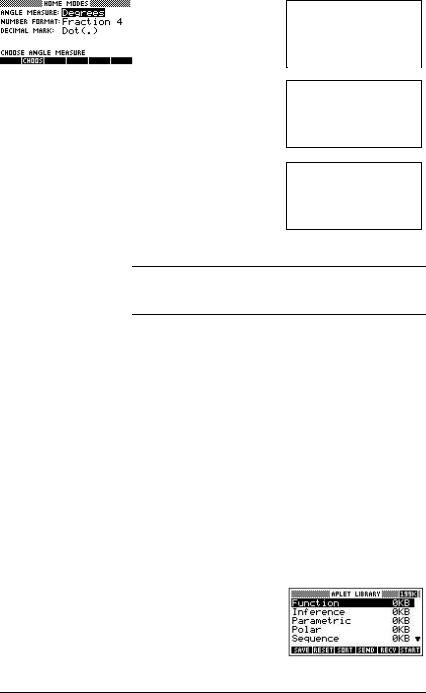
The cursor (highlight) is in the first field, Angle Measure.
2.Press  to display a list of choices.
to display a list of choices.
3.Press  to select Degrees, and press
to select Degrees, and press
 . The angle measure changes to degrees.
. The angle measure changes to degrees.
4.Press  to return to HOME.
to return to HOME.
H I N T Whenever an input form has a list of choices for a field, you can press  to cycle through them instead of using
to cycle through them instead of using
 .
.
Aplets (E-lessons)
Aplets are the application environments where you explore different classes of mathematical operations. You select the aplet that you want to work with.
Aplets come from a variety of sources:
•Built-in the HP 39gs (initial purchase).
•Aplets created by saving existing aplets, which have been modified, with specific configurations. See “Creating new aplets based on existing aplets” on page 19-1.
•Downloaded from HP’s Calculators web site.
•Copied from another calculator.
Aplets are stored in the Aplet library. See “Aplet library” on page 1-16 for further information.
You can modify
configuration settings for the graphical, tabular, and
1-12 |
Getting started |

symbolic views of the aplets in the following table. See “Aplet view configuration” on page 1-18 for further information.
Aplet |
Use this aplet to explore: |
name |
|
|
|
Function |
Real-valued, rectangular functions y in |
|
terms of x. Example: y = 2x2 + 3x + 5 . |
Inference |
Confidence intervals and Hypothesis |
|
tests based on the Normal and |
|
Students-t distributions. |
Parametric |
Parametric relations x and y in terms of |
|
t. Example: x = cos(t) and y = sin(t). |
Polar |
Polar functions r in terms of an angle θ. |
|
Example: r = 2 cos(4θ) . |
Sequence |
Sequence functions U in terms of n, or |
|
in terms of previous terms in the same or |
|
another sequence, such as Un – 1 and |
|
Un – 2 . Example: U1 = 0 , U2 = 1 |
|
and Un = Un – 2 + Un – 1 . |
Solve |
Equations in one or more real-valued |
|
variables. Example: x + 1 = x2 – x – 2 . |
Finance |
Time Value of Money (TVM) |
|
calculations. |
Linear |
Solutions to sets of two or three linear |
Solver |
equations. |
Triangle |
Unknown values for the lengths and |
Solver |
angles of triangles. |
Statistics |
One-variable (x) or two-variable (x and |
|
y) statistical data. |
|
|
In addition to these aplets, which can be used in a variety of applications, the HP 39gs is supplied with two teaching aplets: Quad Explorer and Trig Explorer. You cannot modify configuration settings for these aplets.
A great many more teaching aplets can be found at HP’s web site and other web sites created by educators, together with accompanying documentation, often with student work sheets. These can be downloaded free of
Getting started |
1-13 |
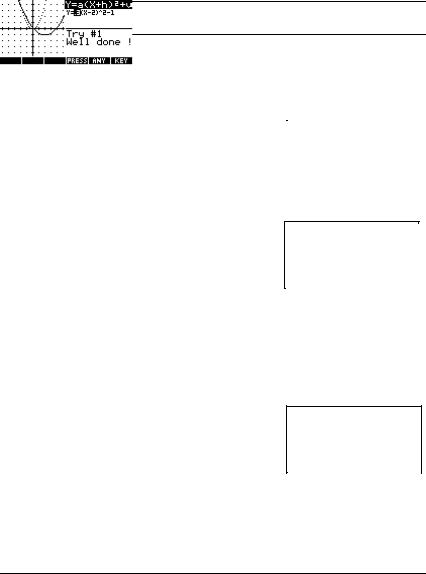
Quad Explorer aplet
charge and transferred to the HP 39gs using the provided Connectivity Kit.
The Quad Explorer aplet is used to investigate the behaviour of y = a(x + h)2 + v as the values of a, h and v change, both by manipulating the equation and seeing the change in the graph, and by manipulating the graph and seeing the change in the equation.
H I N T More detailed documentation, and an accompanying student work sheet can be found at HP’s web site.
Press |
, select Quad |
|
||
Explorer, and then press |
|
|||
. The Quad Explorer |
|
|||
aplet opens in |
|
|
||
mode, in which the arrow |
|
|||
keys, the |
and |
keys, |
|
|
and the |
|
key are used to change the shape of the |
||
|
||||
graph. This changing shape is reflected in the equation displayed at the top right corner of the screen, while the original graph is retained for comparison. In this mode the graph controls the equation.
It is also possible to have the equation control the graph. Pressing  displays a sub-expression of your equation.
displays a sub-expression of your equation.
Pressing the  and
and  key moves between subexpressions, while pressing the
key moves between subexpressions, while pressing the  and
and  key changes their values.
key changes their values.
Pressing  allows the user to select whether all three sub-expressions will be explored at once or only one at a time.
allows the user to select whether all three sub-expressions will be explored at once or only one at a time.
A  button is provided to evaluate the student’s knowledge. Pressing
button is provided to evaluate the student’s knowledge. Pressing  displays a target quadratic graph. The student must
displays a target quadratic graph. The student must
manipulate the equation’s parameters to make the equation match the target graph. When a student feels that they have correctly chosen the parameters a  button evaluates the answer and provide feedback. An
button evaluates the answer and provide feedback. An
 button is provided for those who give up!
button is provided for those who give up!
1-14 |
Getting started |
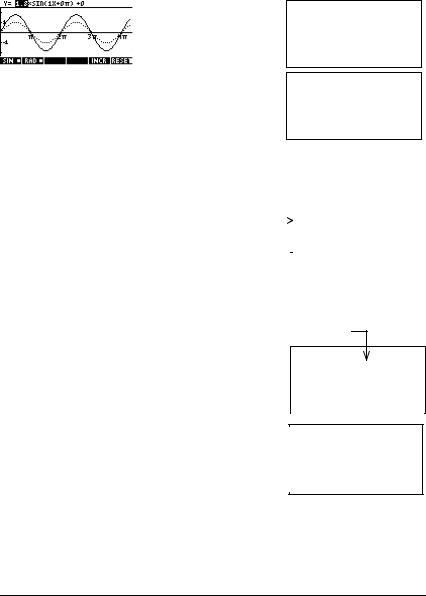
Trig Explorer aplet The Trig Explorer aplet is used to investigate the behaviour of the graph of y = a sin(bx + c) + d as the values of a, b, c and d change, both by manipulating the equation and seeing the change in the graph, or by manipulating the graph and seeing the change in the equation.
Press  , select Trig Explorer, and then press
, select Trig Explorer, and then press  to display the screen shown right.
to display the screen shown right.
In this mode, the graph controls the equation. Pressing the 
 and
and 
 keys transforms the graph, with these
keys transforms the graph, with these
transformations reflected in the equation.
The button labelled |
is |
|
Origin |
|
||
a toggle between |
|
|
|
|
||
|
|
|
|
|
||
and |
. When |
|
|
|
|
|
is chosen, the ‘point of |
|
|
|
|
|
|
control’ is at the origin (0,0) |
|
|
|
|
||
and the |
and |
|
|
|
|
|
keys control vertical and |
|
|
|
|
|
|
horizontal transformations. When |
is chosen the |
|||||
‘point of control’ is on the first extremum of the graph (i.e. for the sine graph at (π ⁄ 2,1) .
The arrow keys change the amplitude and frequency of the graph. This is most easily seen by experimenting.
Pressing  displays the equation at the top of the screen. The equation is controlled by the graph. Pressing the
displays the equation at the top of the screen. The equation is controlled by the graph. Pressing the  and
and  keys moves from parameter to parameter. Pressing the
keys moves from parameter to parameter. Pressing the  parameter’s values.
parameter’s values.
Extremum
or  key changes the
key changes the
The default angle setting for this aplet is radians. The angle setting can be changed to degrees by pressing  .
.
Getting started |
1-15 |
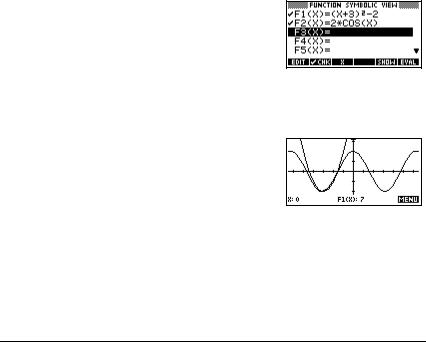
Aplet library
Aplets are stored in the Aplet library.
To open an aplet Press  to display the Aplet library menu. Select the aplet and press
to display the Aplet library menu. Select the aplet and press  or
or  .
.
From within an aplet, you can return to HOME any time by pressing  .
.
Aplet views
Symbolic view
Plot view
When you have configured an aplet to define the relation or data that you want to explore, you can display it in different views. Here are illustrations of the three major aplet views (Symbolic, Plot, and Numeric), the six supporting aplet views (from the VIEWS menu), and the two user-defined views (Note and Sketch).
Note: some aplets—such as the Linear Solver aplet and the Triangle Solver aplet—only have a single view, the Numeric view.
Press  to display the aplet’s Symbolic view.
to display the aplet’s Symbolic view.
You use this view to define the function(s) or equation(s) that you want to explore.
See “About the Symbolic view” on page 2-1 for further information.
Press  to display the aplet’s Plot view.
to display the aplet’s Plot view.
In this view, the functions that you have defined are displayed graphically.
See “About the Plot view” on page 2-5 for further information.
1-16 |
Getting started |
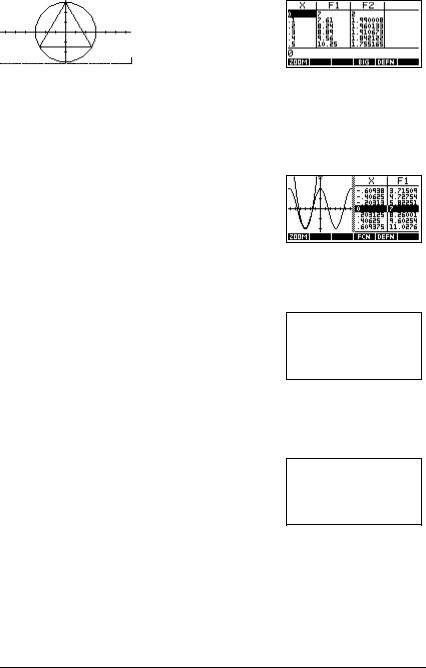
Numeric view
Plot-Table view
Plot-Detail view
Overlay Plot view
Press  to display the aplet’s Numeric view.
to display the aplet’s Numeric view.
In this view, the functions that you have defined are displayed in tabular format.
See “About the numeric view” on page 2-16 for further information.
The VIEWS menu contains the Plot-Table view.
Select Plot-Table 
Splits the screen into the plot and the data table. See “Other views for scaling and splitting the graph” on
page 2-13 for futher information.
The VIEWS menu contains the Plot-Detail view.
Select Plot-Detail 
Splits the screen into the plot and a close-up.
See “Other views for scaling and splitting the graph” on page 2-13 for further information.
The VIEWS menu contains the Overlay Plot view.
Select Overlay Plot 
Plots the current expression(s) without erasing any pre-existing plot(s).
See “Other views for scaling and splitting the graph” on page 2-13 for further information.
Getting started |
1-17 |

Note view
Sketch view
Press  NOTE to display the aplet’s note view.
NOTE to display the aplet’s note view.
This note is transferred with the aplet if it is sent to another calculator or to a PC. A note view contains text to supplement an aplet.
See “Notes and sketches” on page 17-1 for further information.
Press  SKETCH to display the aplet’s sketch view.
SKETCH to display the aplet’s sketch view.
Displays pictures to supplement an aplet.
See “Notes and sketches” on page 17-1 for further information.
Aplet view configuration
Plot Setup
Numeric Setup
Symbolic Setup
You use the SETUP keys (
 , and
, and 
 ) to configure the aplet. For example, press
) to configure the aplet. For example, press 
SETUP-PLOT (
 ) to display the input form for setting the aplet’s plot settings. Angle measure is controlled using the MODES view.
) to display the input form for setting the aplet’s plot settings. Angle measure is controlled using the MODES view.
Press  SETUP-PLOT. Sets parameters to plot a graph.
SETUP-PLOT. Sets parameters to plot a graph.
Press  SETUP-NUM. Sets parameters for building a table of numeric values.
SETUP-NUM. Sets parameters for building a table of numeric values.
This view is only available in the Statistics aplet in  mode, where it plays an important role in choosing data models.
mode, where it plays an important role in choosing data models.
Press  SETUP-SYMB.
SETUP-SYMB.
1-18 |
Getting started |

To change views Each view is a separate environment. To change a view, select a different view by pressing  ,
,  ,
,  keys or select a view from the VIEWS menu. To change to HOME, press
keys or select a view from the VIEWS menu. To change to HOME, press  . You do not explicitly close the current view, you just enter another one—like passing from one room into another in a house. Data that you enter is automatically saved as you enter it.
. You do not explicitly close the current view, you just enter another one—like passing from one room into another in a house. Data that you enter is automatically saved as you enter it.
To save aplet configuration
You can save an aplet configuration that you have used, and transfer the aplet to other HP 39gs calculators. See “Creating new aplets based on existing aplets” on page 19-1.
Mathematical calculations
Where to start
The most commonly used math operations are available from the keyboard. Access to the rest of the math functions is via the MATH menu ( ).
).
To access programming commands, press  CMDS. See “Programming commands” on page 18-13 for further information.
CMDS. See “Programming commands” on page 18-13 for further information.
The home base for the calculator is the HOME view
( ). You can do all calculations here, and you can access all
). You can do all calculations here, and you can access all  operations.
operations.
Entering expressions
•Enter an expression into the HP 39gs in the same left- to-right order that you would write the expression. This is called algebraic entry.
•To enter functions, select the key or MATH menu item for that function. You can also enter a function by using the Alpha keys to spell out its name.
•Press  to evaluate the expression you have in the edit line (where the blinking cursor is). An expression can contain numbers, functions, and variables.
to evaluate the expression you have in the edit line (where the blinking cursor is). An expression can contain numbers, functions, and variables.
Getting started |
1-19 |
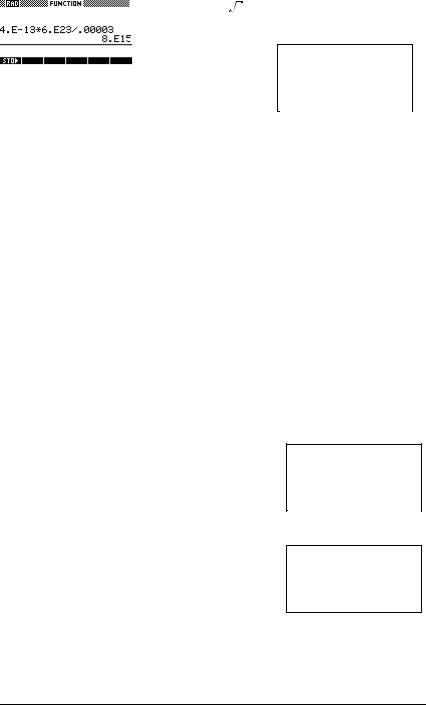
Example
Long results
Negative numbers
Scientific notation (powers of 10)
Example
Calculate |
232 |
– 14 |
8 |
ln(45) : |
--------------------------- |
–3 |
|
||
|
|
|
|
 23
23
 14
14

 8
8

 3
3
 45
45
If the result is too long to fit on the display line, or if you want to see an expression in textbook format, press  to highlight it and then press
to highlight it and then press  .
.
Type  to start a negative number or to insert a negative sign.
to start a negative number or to insert a negative sign.
To raise a negative number to a power, enclose it in parentheses. For example, (–5)2 = 25, whereas –52 = –25.
A number like 5 × 104 or 3.21 × 10–7 is written in scientific notation, that is, in terms of powers of ten. This is simpler to work with than 50000 or 0.000000321. To enter numbers like these, use EEX. (This is easier than using  10
10  .)
.)
(4 × 10–13)(6 × 1023)
Calculate ----------------------------------------------------
3 × 10–5
 4
4  EEX
EEX
 13
13 
6  EEX
EEX
23
 3
3  EEX
EEX
 5
5
Explicit and implicit multiplication
Implied multiplication takes place when two operands appear with no operator in between. If you enter AB, for example, the result is A*B.
1-20 |
Getting started |
